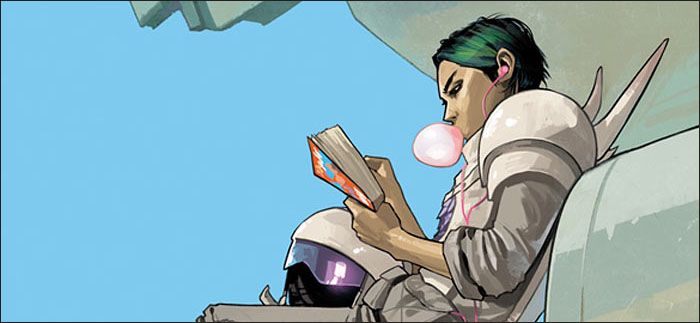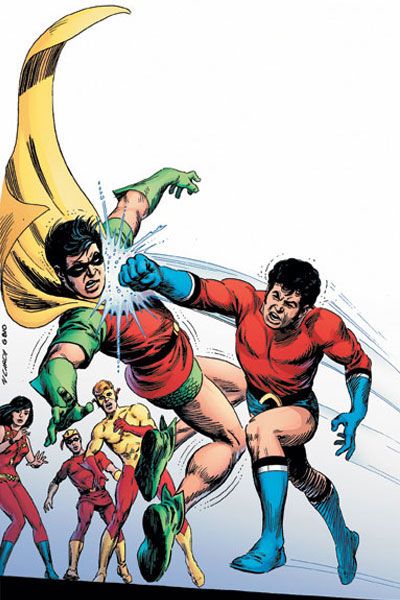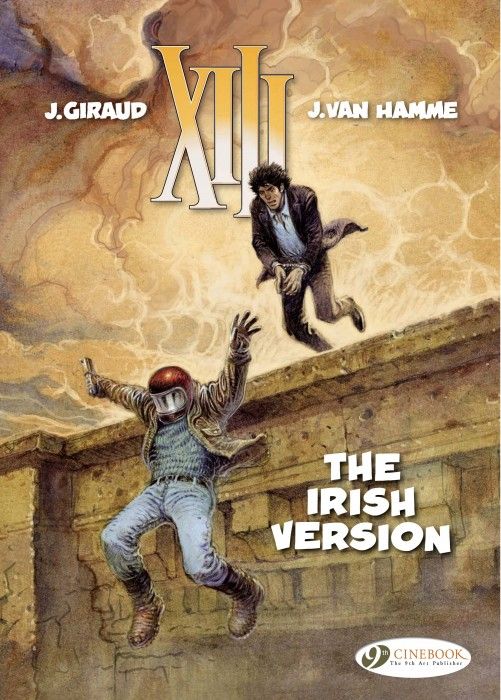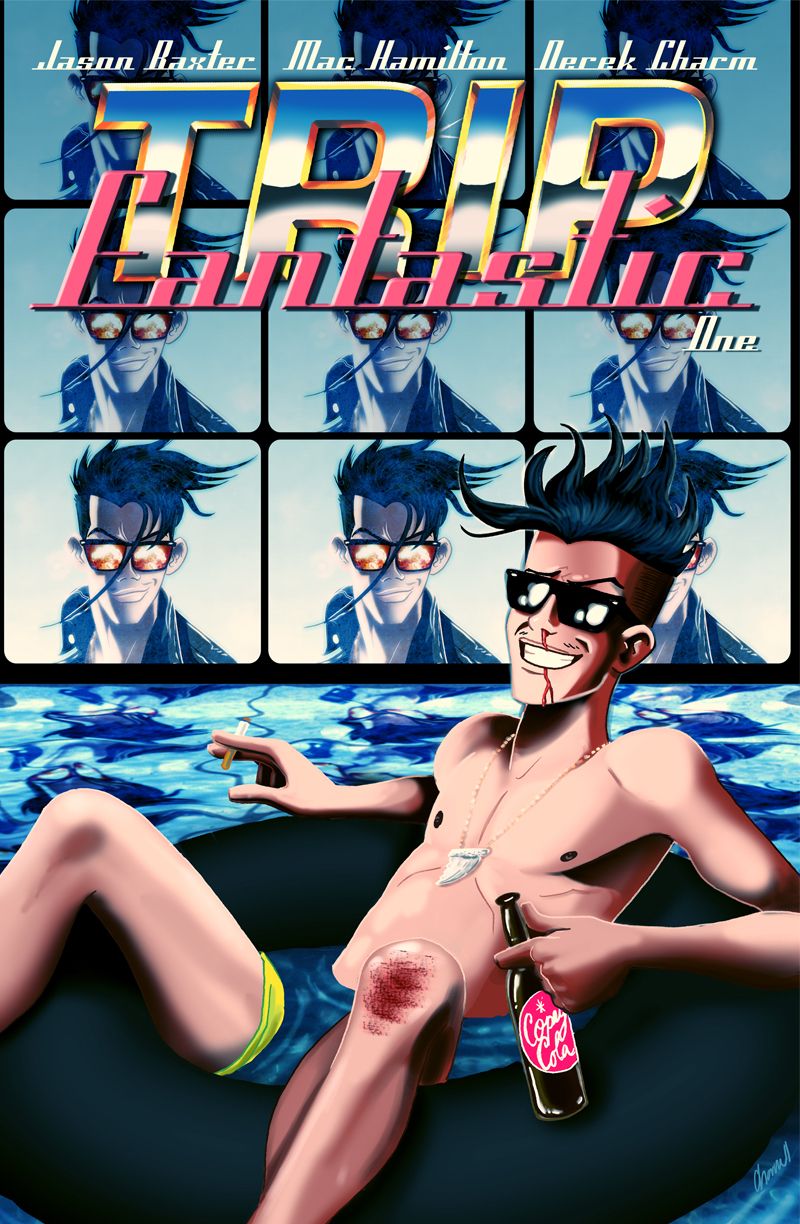Happy Sunday and welcome to What Are You Reading?, our weekly look at all the comics and other stuff we’ve been reading lately. Today our special guest is Dave Dwonch, creative director at Action Lab Entertainment and the writer of such comics as Space-Time Condominium, the upcoming Ghost Town, Double-Jumpers and more.
To see what Dave and the Robot 6 crew have been reading, click below.
*****
Tom Bondurant
Last week's traveling gave me time to read, so I started plowing through Showcase Presents Teen Titans Volume 2, by Bob Haney, Neal Adams, Nick Cardy, Gil Kane, and assorted other writers and artists. I'm just now getting into the "Mr. Jupiter" stories, where the Titans (minus Robin) renounce costumes and powers after being part of a fight which results in the death of a peace activist. Those are well-meaning, but not very thrilling. (Flipping ahead in the book also reveals that the new direction didn't last very long.) More involving -- and part of the reason I couldn't put this book down -- are stories like Adams' three-issue extradimensional-invasion arc in #20-22 and "Skis Of Death" in #24. You snicker, but "Skis" (written by Haney, pencilled by Kane, inked by Cardy) is a perfectly serviceable standalone story about who's going to buy some rickety old resort, because it happens to be sitting on some valuable resource and it's important to the locals, and there's a teenaged "civilian" involved. It's like a Scooby-Doo story which has to explain why bad guys can knock out Kid Flash, and despite its shortcomings, it has a certain charm.
I also read the first arc of Shaenon Garrity's Narbonic, the lighthearted story of mad scientists and their interns. I'm late to Narbonic, but I liked her X-Files cartoon recaps pretty well and wanted to show my support. So far, so good, as Narbonic is alternately frenetic and easygoing, not unlike Bloom County at its best.
Finally, since I spent most of the week with Grant Morrison, Rags Morales, and the rest of the Action Comics crew, I re-read "Whatever Happened To The Man Of Tomorrow?" (written by Alan Moore, pencilled by Curt Swan, and inked by George Perez and Kurt Schaffenberger). Of course, there wasn't much new on this reading. In fact, I knew it would be 90% depressing (with the 10% for that last wink), and once again, it was. I mean, it's a well-constructed story, and it looks great, but it's not exactly a victory lap for 48 years' worth of Superman stories. I suppose it works pretty well as a bookend for the very first Clark/Lois scenes in Action vol. 1 #1, and it pretty much puts a period on all the Silver Age wackiness, but otherwise it's just kinda brutal.
Okay, I can't end on a down note, so I forgot about one book from last weekend -- Matt Fraction and Daniel Aja's first Hawkeye paperback. I had high expectations for this book, based on its rave reviews, and it is pretty fun. I liked Hawkeye already, but Kate, the Tracksuit Mafia, and (obviously) the dog are new to me, and I'm digging them too. So, yay Hawkeye!
Mark Kardwell
So last Sunday was St. Patrick's Day, and completely coincidentally I read Jean Van Hamme and Jean Giraud's "The Irish Version," the latest XIII translation from Cinebook. It's got its problems, but I liked it a lot. Both the Belgian writer and the late legendary French artist have done a lot of research, all gratifying, all visible on the page. The translator, Jerome Saincantin, has also done an outstanding job, capturing the unique colloquial rhythms and dialects of Northern Ireland. It's a pet peeve when any publisher shrinks a European album to give it the same spine length as an American comic: it makes everything seem a little cramped afterwards. The reproduction seems a little dark in places, too, probably because of the paper stock. Basically all my problems with the book come from me being a grumpy old man whose eyesight isn't as good as it used to be. The best comic about the conflict in Northern Ireland remains Garth Ennis and John McCrea's Troubled Souls, though they'd probably both be a little embarrassed to be reminded of it now. Ennis understood that all the political theory and flags used by both sides were just smokescreens to cover gangsterism and a shitty little tribal war. Van Hamme, as an outsider, takes the political arguments a little too much at face value. Some of us were born into this crap, we can't see the grand sweep of European history. We're too busy resenting our neighbors for supporting the wrong football team.
Brigid Alverson
Native American Classics is the latest anthology from the Graphic Classics folks, and like all the previous volumes, it is colorful, interesting and a bit surprising. Editor Tom Pomplun has assembled a set of poems and stories written between about 1850 and 1920, and while some are traditional folk stories, others document the ways that Native Americans and Anglos rubbed up against one another. These are not happy stories: In "The Soft-Hearted Sioux," a young man turns against his upbringing and becomes a missionary, with disastrous results. In "The Middle-Man," a Cherokee man is complicit in swindling an older woman. Most of the contributors are Native Americans, and this slim volume encompasses a wide range of art and storytelling styles. I wouldn't try to read it through at one sitting, but it's great to dip into and read a couple of stories at a time.
My kids are big Adventure Time fans, but my kids are 18 and 20. I just read the latest two issues of BOOM!'s comic, Adventure Time #13 and 14, and I thought a lot of the main story would fly right over a seven-year-old's head. Maybe they just skip the words and focus on the action? There's lots of imaginative fighting, as Finn, Jake and Princess Marcelline face off against a digital monster made up of zillions of computers and video games. It's a cool story and handled in an imaginative way, both visually and verbally. What I enjoyed even more, though, was the two-part side story by Chris Schweizer, "Princess of Rad Hats," in which Finn accidentally becomes a princess and has to take on all the responsibilities and privileges thereof. It's a funny spin on princess movie clichés, with a clever twist ending.
Tim O'Shea
The Superior Spider-Man #6: Writer Dan Slott has set out to show how Doc Ock, when given the chance is actually the worst Spider-Man ever—the farthest from superior. It is amazing how much, despite Ock’s best intentions at times, his insecurities dictate his actions. I would love to know what little people advocates think of the introduction of Anna Maria Marconi to the cast. Here’s hoping that the “Parker pursues his PhD” plotline or at the very least Marconi stays in the Spidey universe after this Ock plotline is resolved. It’s refreshing to have a unique person who is not defined by her condition (though it is clearly exploited in this issue) and it would be great if she became a cast regular.
Captain Marvel #11: In terms of enjoying the writing, it drives me crazy when two people are writing (in this case Kelly Sue DeConnick and Christopher Sebela). If I enjoy the dialogue, who do I credit for that, is DeConnick plotting while Sebela handles dialogue? Who knows. But anyhow, a grounded Carol Danvers gives the writing team a chance to explore other ways she can use her skills without exacerbating her ongoing medical condition that prevents her from flying. Also, kudos to whomever added Dakota North to the cast, it would make sense that she and Danvers would click. As a person who bailed because of weak art at the start of this series, I must stress how while Filipe Andrade has a quirky art style, I think it works well for this series.
Daredevil #24: I know we already have 400 Avengers titles, but writer Mark Waid and artist Chris Samnee should have an Avengers book. In two pages, Daredevil and Hank Pym have one of the most hilarious phone conversations I have seen in a comic. And it’s all because Hank changes sizes throughout the exchange. At first, Matt complains because Hank is shouting into the phone (because he is giant sized), later on he laments that “you sound like a cartoon mouse” as he becomes the size of the cell phone. Samnee pulls the whole thing off effortlessly and even tosses in a great bit where Murdock is ID’d on his phone in silhouette in a way that looks like he is DD, but is not DD. You have to see it to understand. But it is a subtle touch that Samnee executes seamlessly (with a major color assist by Javier Rodriquez. Extra points to Waid for juggling Murdock’s civilian life and hero life in a balanced manner.
Indestructible Hulk #5: As much as I love Waid’s writing on this series, Leinil Francis Yu’s art is hindering my ability to heartily recommend this series. I really gave it a try, thinking: “It’s not Yu, it’s me.” (pun intended). I must stress, Yu has a spectacular eye for layout and can draw monsters like few others—but respected veteran inker Gerry Alanguilan’s penchant for detail in faces and bodies overburdens the art. Going forward, as teased in the last page of this issue: “Next Issue: 04013--Hulk. Thor. Simonson. ‘Nuff said.” No way I am giving up on the series as a whole with plans like that in the pipeline. If any Yu/Alanguilan fans would love to make a case in the comments section for what I am failing to appreciate about their work, please know I am always willing to consider other views.
David Dwonch
Right now I’m catching up on stuff I’ve picked up recently at conventions. Lots of odds and ends and surprise finds, and nothing more surprising comes to mind than Trip Fantastic. Originally launched as a webseries at tripfantasticonline.com, and seeing print after a successful Kickstarter, Trip Fantastic tells the story rise and fall of Trip Fantastic, the world’s most beloved reality TV star drug addled daredevil. The story is a bit all over the place, but it’s meant to be, as we follow Trip down the rabbit hole of his own psyche. Writers Jason Baxter and Mac Hamilton do a great job developing Trip and his oddball cast of tagalongs, and Derek Charm’s art is just absolutely amazing. Charm’s art is a mixture of anime, Darwyn Cooke, and indie flair that just beats you into submission, almost daring you to be offended by his palette choices. And it all works so brilliantly, you can’t help but be along for Trip Fantastic’s train wreck of a life.
Initially I wrote Saga off as a simple star crossed Romeo and Juliet story, but after hearing so many great reviews I picked up the first trade to find out ... that’s exactly what it is. Fortunately, BKV and Fiona Staples are master storytellers and they’ve created a universe that is oddly familiar and accessible, yet also batshit crazy. I’m catching up now (just finished issue 8) and Saga continues to win me over. It feels like home, somehow.
I picked up the Nausicaa of the Valley of the Wind manga collection a couple months back, and I’m slowly working my way through the series. I remember loving the movie as a kid, and the manga is reminding me why it was so important to me then. Miyazaki was on another level even back then; his attention to detail, his unique sensibilities, storytelling and message is all on the page. I’m doing my best to savor it.





